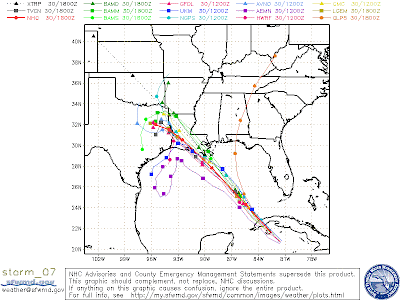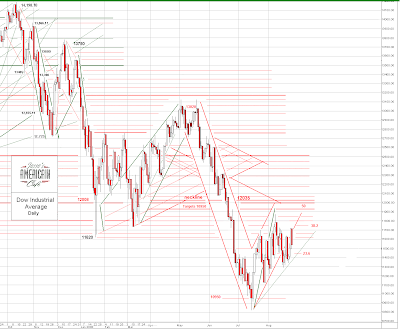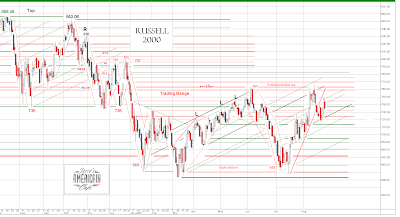Most U.S. Gulf oil output shut as Gustav threatens
Sun Aug 31, 2008 9:55am EDT
Reuters
U.S. crude oil fell from a record high $147.27 a barrel in July to close at $115.46 on Friday.
The New York Mercantile Exchange on Saturday moved up Sunday's start time for electronic trading of energy contracts to 2:30 p.m. EDT from 6 p.m. EDT. (To facilitate the evacuation of the oil shorts? Or to enable the spin that its no big deal and the Strategic Petroleum Reserve will provide emergency aid? Stay tuned. - Jesse)
Katrina and Hurricane Rita that followed on its heels destroyed 124 offshore platforms, temporarily shuttered about 30 percent of U.S. refining capacity and left nearly a quarter of offshore Gulf oil production shut up to nine months later.
The Gulf provides a quarter of U.S. oil output and 15 percent of natural gas production.
Shell, the region's largest producer at 370,000 barrels of oil equivalent per day, was shutting all offshore oil and natural gas production on Saturday.
BP said it was also shutting its Gulf production on Saturday, while Exxon Mobil Corp said 5,000 barrels of oil output and 50 million cubic feet per day in natural gas production was shut by Saturday morning.
PRODUCTION CUTS
Six Louisiana refineries that process 1,305,000 barrels per day of crude oil -- 7.4 percent of U.S. refining capacity -- were closing down for the storm, while a total of 12.4 percent of U.S. refining capacity had been affected in someway.
Mississippi River traffic south of New Orleans closed at 6 p.m. CDT. Ship channels into Lake Charles in west Louisiana and Beaumont and Port Arthur in east Texas planned to shut by Sunday night, cutting off crude oil shipments to refineries.
The Louisiana Offshore Oil Port, the only U.S. deepwater port capable of offloading giant oil tankers, stopped taking crude from ships on Saturday, a spokeswoman said, but continued to supply refiners from onshore crude oil tanks.
31 August 2008
The Oil Complex Buttons Down while the NYMEX Opens Early
30 August 2008
Gustav Intensifies to Category 4 Hurricane, May Turn More Deadly
FEMA says Gustav soon to be rated Category 5 storm
Aug 30 03:34 PM US/Eastern
By JENNIFER LOVEN
Associated Press Writer
WASHINGTON (AP) - The government's disaster relief chief says Hurricane Gustav is growing into a monster Category 5 storm. The storm that hit Cuba Saturday could reach landfall along the Gulf Coast by early Tuesday.
Federal Emergency Management Agency chief David Paulison told reporters several times at a briefing Saturday that the storm was strengthening into a Category 5 hurricane.
FEMA officials said Bill Read, the director of the National Hurricane Center, interrupted an afternoon teleconference involving the agency, Gulf Coast states and the National Weather Service to say he is going to issue a special advisory statement raising Gustav to Category 5. That means winds greater than 155 mph and a storm surge greater than 18 feet above normal.
Word about the Category 5 development reached FEMA shortly before Paulison briefed reporters.
THIS IS A BREAKING NEWS UPDATE.
Courtesy of Joe Bastardi, chief hurricane forecaster for AccuWeather – www.AccuWeather.com – here is the map every investor needs to keep at his or her fingertips. It shows the hurricane path that Bastardi says would cause the greatest damage to offshore and onshore energy facilities in the U.S. Gulf of Mexico. In an interview with EnergyTechStocks.com, Bastardi called it the path of the “Ultimate Storm.”
Energy experts say the ultimate storm would send spot oil and gas prices up sharply and keep them there for an extended period unless, by some miracle, the damage inflicted was only minor. (It would probably be several days before oil company personnel could conduct a full assessment.)


GDP Second Quarter Was More Likely Negative, Perhaps Remarkably So
This excerpt is from this week's Up and Down Wall Street commentary by Alan Abelson in Barron's. It echoes what we said in this blog immediately after the GDP revision for the second quarter came out.
We subscribe to Barron's and read it every week. We recommend it as a good weekly source of market news and commentary.
People do not like to accept that the government is misleading us with the economic numbers. It shakes their faith in their leaders and the system, and it creates the problem of having to think for themselves.
However, there are times when the case is so clear you just have to say what David Rosenberg of Merrill Lynch says at the end of Alan Abelson's column.
GDP, IN COMMON PARLANCE, stands for gross domestic product, or the aggregate value of all the goods and services produced on these blessed shores. Or, at least, that's what it used to mean in those long-gone days of yore, when life was simpler and government statistics credible. These days, alas, those initials more typically signify "gross deceptive pap."
The insidious change has not gone unremarked, both in this magazine and by more than one skeptical scanner of the turgid flow of numbers flowing out of Washington. Yet purportedly professional seers, who draw handsome paychecks for sifting through the unending streams of digits and making sense of them for hoi polloi like us, deferentially pass along the official numbers unsullied by even a modicum of analysis, as if they were holy writ, especially when they're upbeat.
A case very much in point was last Thursday's revised report on second-quarter GDP, which helped spark a nice, if something less than enduring, leap forward by the stock market. The initial version released in July posited that the venerable economic barometer had risen by 1.9% -- up from the first quarter's meager 0.9% gain, but obviously no great shakes.
Comes now the so-called preliminary estimate that claims second-quarter GDP grew by a much more robust 3.3%. That was hailed by the incorrigibly constructive contingent in the Street as evidence of the resiliency (favorite word) of the economy and prompted the thinned-out ranks of investors to put their worries and their plans for an extra-long weekend on hold and pile into stocks. Hooray! Hooray!
But even a cursory look at what they're drooling over reveals pretty thin gruel. Nothing, for sure, that would cause any sentient being to start humming "Happy Days Are Here Again." For the ostensibly better GDP showing is a mirage, conjured up by the usual suspects out of smoke and mirrors.
The key here is the GDP deflator, which purports to adjust GDP for the impact of inflation; it's a curious calculation in that, contrary to its moniker, it seems designed to do the exact opposite of deflating GDP.
Thus, according to this accommodating measure (accommodating, that is, if you're determined to put a good face on a dreary report), inflation grew at an improbably restrained 1.33% in April-June. And maybe it did -- but not in the good old U.S. of A. However, obviously more important than accuracy to those doing the calculating is this simple equation: The lower the deflator, the greater the growth of GDP.
John Williams of Shadow Government Statistics, whose incisive description of the decades of willful distortion of inflation by Washington we cited a few weeks ago, points out that the supposed 1.33% increase in the second quarter would represent the lowest inflation rate in five years. Must be that plain folks stubbornly refuse to recognize the dramatic drop in inflation, because, as Phil Gramm said, we're such a bunch of whiners.
Of course, even by the government's not entirely extravagant figuring, the consumer-price index was up a hefty 8% in the latest quarter. Perhaps the computer that tallies the CPI doesn't talk to the computer that measures the deflator.
By John's reckoning, "a second-quarter year-to-year contraction of 2.9% would have been more in line with underlying fundamentals, past methodologies and the ongoing recession."
He suggests that a more telling picture of the economy's progress or lack of it is the alternative to GDP, known as gross domestic income, or GDI. It's a rough equivalent of GDP but measures the nation's income instead of production.
According to John, after adjusting for inflation, GDI in the June quarter weighed in at an anemic 0.5%, atop negative growth in the preceding two quarters -- which, as it happens, meets the popular definition of a recession.
Friday's disclosure that personal income in July suffered its biggest decline in three years doesn't exactly portend a rebound in the third quarter, and certainly didn't come as a big surprise to John, who sees the outlook for the economy remaining glum, with no early end to the banks' solvency crisis, as he terms it, nor the inflationary recession.
THE ASTUTE ECONOMY-WATCHER for Merrill Lynch, David Rosenberg, also strongly advises digesting the suspect GDP report with a "very large grain of salt." Among other things, he casts a skeptical eye on how the report treats the decline in corporate profits. (We won't keep you in suspense: The answer is: "gingerly.")
More specifically, he notes, "national-account corporate profits declined at a 9.2% rate in the second quarter." For domestic industries, he goes on, profits are down 14.4% year over year.
But according to the GDP report, domestic nonfinancial profits fell at a much sharper 22% annual rate. The reason the drop in total corporate earnings was limited to 9.2% was that, David relates, profits in the financial sector, so claims the report, surged -- get this -- at a 27% annual rate.
His wonderfully eloquent comment:
"Are you kidding me?"




































